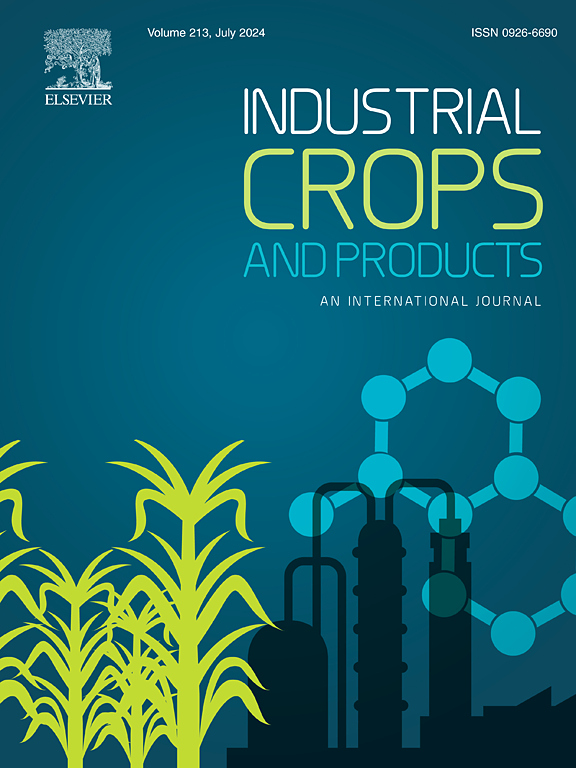对MYB的综合分析旨在确定参与天然橡胶生物合成调控的基因
IF 5.6
1区 农林科学
Q1 AGRICULTURAL ENGINEERING
引用次数: 0
摘要
巴西橡胶树(Hevea brasiliensis)是大豆科植物中唯一能够产生天然橡胶的物种,具有相当大的经济和工业意义。全面分析与NR生物合成相关的MYB基因的进化模式和功能作用,对巴西猿猴的遗传改良具有重要意义。MYB基因的进化模式表明,与大戟科和桉树亚科相比,藜亚科的祖先基因在扩展。巴西人MYB基因数量最多,全基因组重复(WGD)或片段重复是促进MYB扩增的主要机制。大戟科myb的数量具有谱系特异性。hbr2r3 - myb基因结构更为保守,而Hb1R-MYB序列变异显著,基因结构更为复杂。209个hbr2r3 - myb被划分为29个亚家族,其中包括4个新亚家族的鉴定。HbMYB88在乙烯利处理后12 h达到表达高峰,并在胶乳和茎中显著表达。此外,HbMYB88在次生乳汁管中表现出低差异表达。HbMYB88定位于细胞核,属于S25亚家族,与细胞分化有关。基于系统发育关系、基因表达模式和基因间调控关系,我们假设HbMYB88通过茉莉酸(Jasmonic acid, JA)通路(coi1 - jaz1 - myc)参与乳汁管细胞分化,从而影响NR的生物合成。酵母One-Hybrid进一步证明HbMYB88可以特异性结合HbMYC-1启动子。本文章由计算机程序翻译,如有差异,请以英文原文为准。
A comprehensive analysis of MYB aimed at identifying genes involved in the regulation of natural rubber biosynthesis
Hevea brasiliensis, the sole species within the Euphorbiaceae family capable of generating natural rubber (NR), holds considerable economic and industrial significance. A comprehensive analysis of the evolutionary model and functional roles of MYB genes related to NR biosynthesis is of vital importance for the genetic improvement of H. brasiliensis. The evolutionary patterns of MYB genes demonstrated an expansion of ancestral genes in the Crotonoideae subfamily, in contrast to the Euphorbioideae and Acalyphoideae subfamilies. H. brasiliensis possessed the largest number of MYB genes, with whole genome duplication (WGD) or segmental duplication identified as the primary mechanism facilitating expansion of MYB. The number of MYBs in the Euphorbiaceae family had lineage specificity. The gene structure of HbR2R3-MYBs was more conserved, while Hb1R-MYB sequences showed significant variations and more complex gene structures. 209 HbR2R3-MYBs were classified into 29 subfamilies, which encompasses the identification of four new subfamilies. HbMYB88 reached peak expression levels at 12 hours after ethephon treatment and was prominently expressed in latex and stems. Moreover, HbMYB88 displayed low differential expression in secondary laticifers. HbMYB88 was localized in the cell nucleus and belonged to the S25 subfamily, which was associated with cell differentiation. Based on phylogenetic relationships, gene expression patterns, and inter-gene regulatory relationships, it was hypothesized that HbMYB88 was involved in laticifer cell differentiation through the Jasmonic acid (JA) pathway (COI1-JAZ-MYC), thereby influencing the biosynthesis of NR. Yeast One-Hybrid further proved that HbMYB88 can specifically bind to the promoter of HbMYC-1.
求助全文
通过发布文献求助,成功后即可免费获取论文全文。
去求助
来源期刊

Industrial Crops and Products
农林科学-农业工程
CiteScore
9.50
自引率
8.50%
发文量
1518
审稿时长
43 days
期刊介绍:
Industrial Crops and Products is an International Journal publishing academic and industrial research on industrial (defined as non-food/non-feed) crops and products. Papers concern both crop-oriented and bio-based materials from crops-oriented research, and should be of interest to an international audience, hypothesis driven, and where comparisons are made statistics performed.
 求助内容:
求助内容: 应助结果提醒方式:
应助结果提醒方式:


